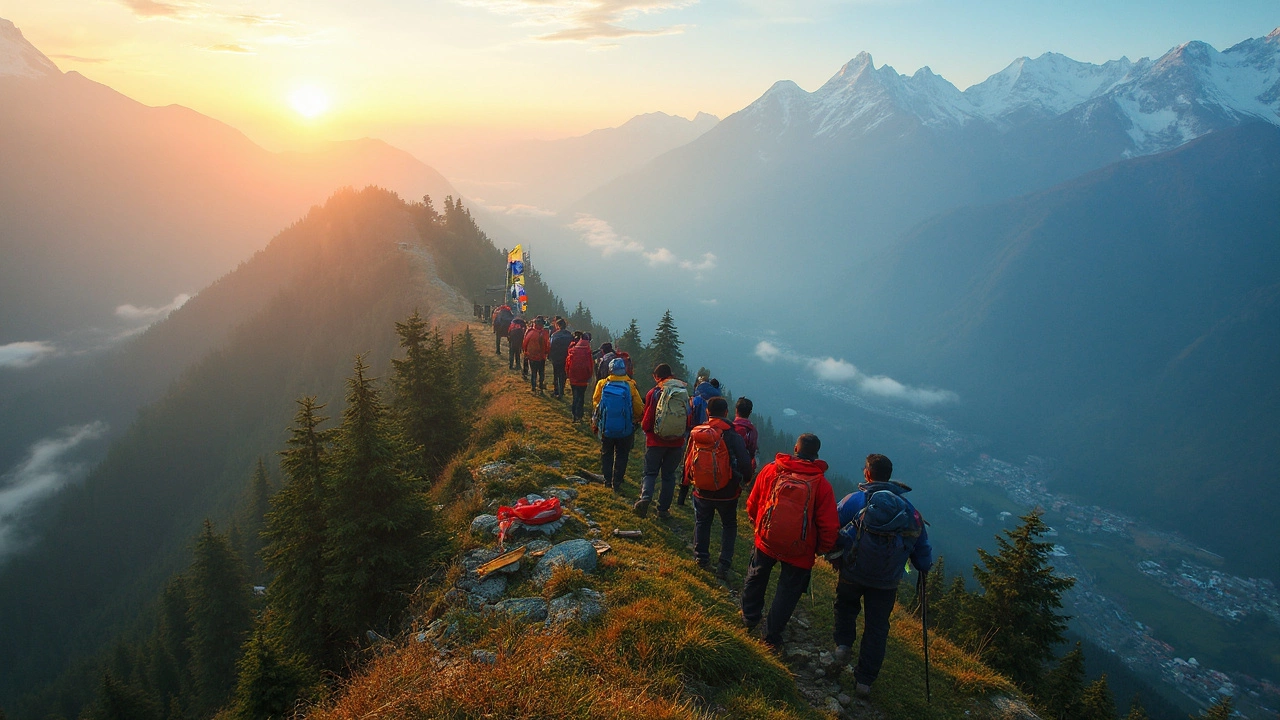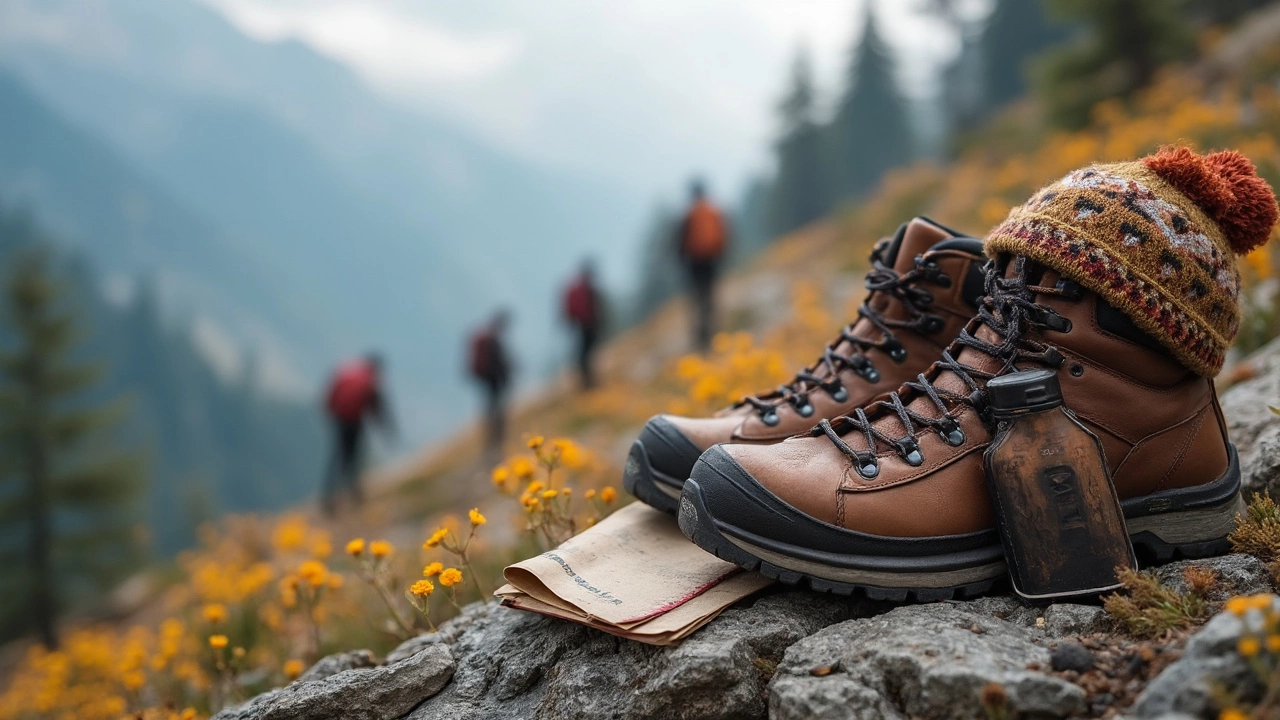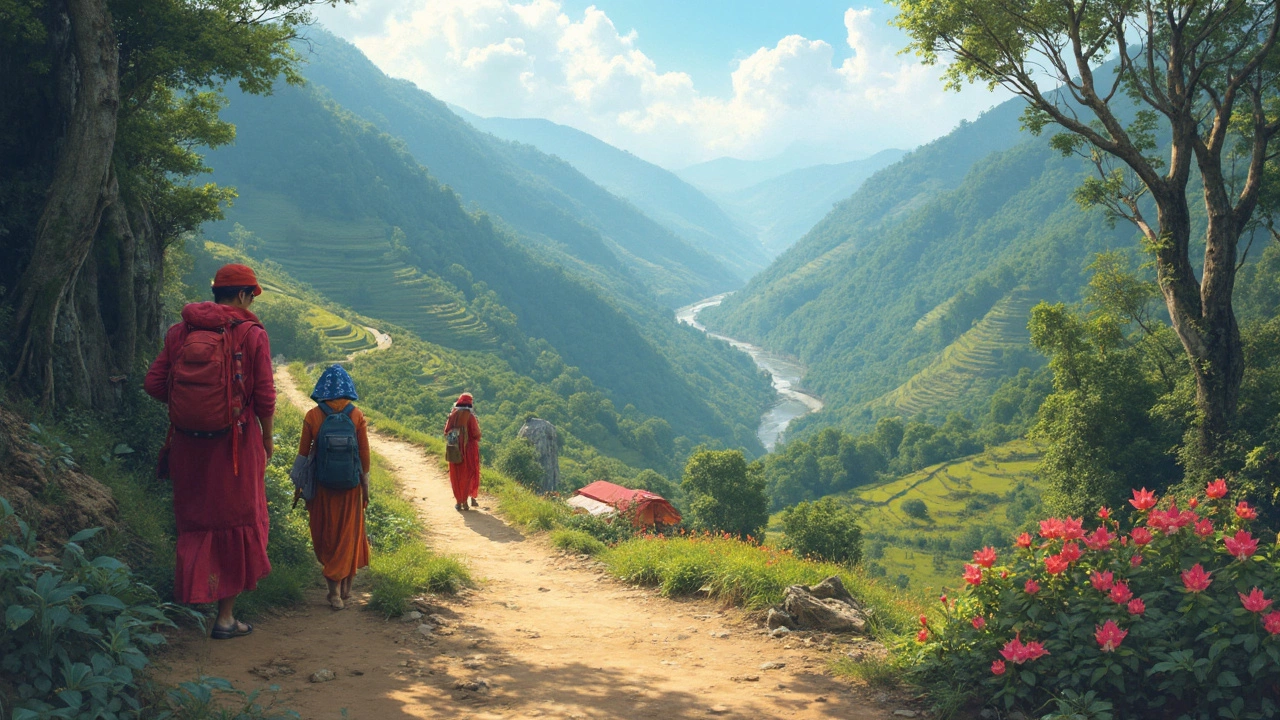Trekking Places India: Is There a World Capital?
 Jun, 3 2025
Jun, 3 2025
Ask a bunch of trekking fanatics about the “world capital of trekking” and expect a heated debate. Nepal and Peru always pop up, but India’s insane variety and scale of trekking places keep it firmly in the conversation. Not many places let you go from thick forests and rivers up to icy Himalayan peaks in the same country. That’s not a marketing line—just look at the map and the local guides who’ve been walking these trails for decades.
So why do so many trekkers rate India’s trails above the rest? First off, there’s the wild diversity—think spiritual trails like the Valley of Flowers or hardcore routes like Chadar’s frozen river in Ladakh. You’ll find everything from bucket-list expeditions to quiet village paths where no one’s heard of Instagram. The best part? Most treks here don’t beat up your wallet like trips in Switzerland or New Zealand.
But India’s not just about variety. The country blends culture, adventure, food, and scenery in ways you won’t find anywhere else. You could be sipping chai in a Ladakhi tent one day and scrambling over boulders above the clouds the next. If you know where to look and how to prep, you’re in for some of the world’s most unforgettable trekking experiences.
- What Makes a 'World Capital of Trekking'?
- Why the Himalayas Steal the Show
- India’s Standout Treks You Can’t Miss
- Smart Tips for Trekking in India
- Hidden Gems and Local Surprises
What Makes a 'World Capital of Trekking'?
So, what’s the checklist for calling somewhere the “world capital of trekking”? It’s not just about having the most trails. We’re talking insane landscape variety, reliable infrastructure, friendly locals, and that special something that makes trekkers want to come back season after season.
First, the sheer number of trail options matters. You want a mix of easy walks and lung-busting climbs. The place should offer options for everyone: families, solo travelers, seasoned climbers, and newbies all need to feel at home. India, for example, has beginner treks like Triund and mega-challenges like the Great Himalayan Trail that can take months to finish.
Next up, there’s the landscape factor. The best places serve up everything: glaciers, forests, rivers, meadows, and maybe even some deserts for good measure. Accessibility isn’t just about roads or airports. It’s also about comfy places to stay, affordable guides, and local food that refuels you at the end of a slog. In India, big trekking hubs like Manali, Rishikesh, or Leh nail this part—whether you’re after budget hostels or a full-blown mountaineering school.
Trek history counts, too. We’re talking places with a real story, maybe some old pilgrim paths or legendary climbs. The best trekking destinations are places you can brag about: “Yeah, I went up to Stok Kangri,” or “I did the Kuari Pass like hikers from a hundred years ago.” Good stories and local legends pump up the experience and stick in your memory.
Let’s see how famous countries stack up based on core things every trekker actually cares about:
| Country | Number of Famous Treks | Peak Season Visitors (approx.) | Trail Diversity |
|---|---|---|---|
| Nepal | 10+ | 120,000+ | High (mountain/forest) |
| Peru | 5+ | 70,000+ | Good (Andes/jungle) |
| India | 25+ | 100,000+ | Very High (desert, forest, snow, meadow) |
| New Zealand | 5+ | 50,000+ | Good (mountain/forest/coast) |
One last thing that makes a place stand out: year-round variety. Monsoon, winter, spring, or autumn—when a region has treks for every season, it keeps the action going. For example, Himachal Pradesh has summer and winter treks, while Uttarakhand shines best from March to June and September to November. So, when someone asks which place holds the crown, look for the one that checks all these boxes and keeps drawing people back.
Why the Himalayas Steal the Show
If there’s one thing trekkers agree on, it’s this: India’s slice of the Himalayas is pretty much unbeatable. The sheer size of the range is just wild—stretching over 2,500 kilometers and crossing five Indian states. From Himachal to Arunachal, there’s barely a corner that doesn’t have something epic to offer. You want brutal altitudes or easy village walks? The Himalayas cover both.
For trekking places India is loaded, but the Himalayas really tip the scales. Some classic routes—like the Roopkund trek in Uttarakhand—pack in alpine lakes, old legends, and forests that go on forever. Markha Valley in Ladakh lets you hike alongside ancient monasteries and through villages that seem frozen in time. Then there’s Stok Kangri, where you hit 6,000 meters if you’re up for the challenge. Even the relatively easy Hampta Pass gives you snow bridges and sudden, jaw-dropping scenery switch-ups.
It’s not just about climbs, though. You get blasts of culture too. Every village has a festival or a story, and people welcome you in for chai like you’re family. Food changes by region—think steaming momos in Sikkim and spicy rajma in Himachal. The mix of adventure and local life is why the Himalayas keep pulling trekkers back.
“Nowhere else on Earth can you combine this level of high-altitude adventure with such rich culture everywhere you turn. It’s not even a contest.” — Arjun Vajpai, Indian mountaineer
Check out some numbers that put things into perspective:
| Region | Popular Trek | Highest Altitude (meters) | Best Trekking Months |
|---|---|---|---|
| Uttarakhand | Roopkund | 5,029 | May–June, Sept–Oct |
| Ladakh | Markha Valley | 5,200 | June–Sept |
| Himachal Pradesh | Hampta Pass | 4,270 | June–Sept |
| Sikkim | Goechala | 4,940 | April–June, Sept–Nov |
Bottom line: The mountains here aren’t just tall—they’re packed with surprises, stories, and a sense of real adventure. That’s why serious trekkers keep calling the Indian Himalayas the trekking places India dream.

India’s Standout Treks You Can’t Miss
If you’re serious about trekking places India offers, you’re spoiled for choice. Whether you’re a total rookie or a mountain maniac, there’s something for you. Let’s break down a few treks that have legit street cred among trekkers everywhere.
- Himalayan gems like the Roopkund trek are legendary. Nicknamed the "Skeleton Lake Trek," Roopkund gained fame because of the hundreds of ancient human skeletons found at the lake, lying exposed at its edge. You hit an altitude of around 5,029 meters, and you’ll catch creepy-cool glacial views before the snow shuts things down for the season (typically open May-June and September-October).
- Valley of Flowers National Park is a full-color blast between July and September. Over 500 rare alpine flower species and, if you’re lucky, blue sheep or the red fox on the slopes. It’s also a UNESCO World Heritage Site for a good reason. This one’s perfect for beginners who want to level up their Insta game and see real-life Himalayan beauty.
- Chadar Trek is the wild card. Each winter, the Zanskar River freezes solid and turns into an icy trail through Ladakh’s deep canyons. It’s more rugged: Only possible January-February, and the temps regularly drop below minus 20°C at night. In 2019, just 1,200 trekkers made it, compared to crowds of 10,000+ on easier Himalayan trails.
- If green meadows and killer views sound good, the Har Ki Dun trek delivers. It sits at around 3,500 meters in Uttarakhand, passes sleepy mountain villages, and finishes with clear sights of high Himalayan peaks. People often spot wild boars, langur monkeys, and loads of rare birds here.
- Want something offbeat? The Sandakphu trek (West Bengal) lets you stand at 3,636 meters and see four out of the world’s five highest peaks: Everest, Kanchenjunga, Lhotse, and Makalu will all be in sight on clear days.
Here’s a quick data rundown of some of India’s most popular treks:
| Trek Name | Region | Highest Altitude (m) | Best Season | Avg. Duration |
|---|---|---|---|---|
| Roopkund | Uttarakhand | 5,029 | May-Jun, Sep-Oct | 8-9 days |
| Valley of Flowers | Uttarakhand | 3,658 | Jul-Sep | 5-6 days |
| Chadar Trek | Ladakh | 3,390 | Jan-Feb | 8-9 days |
| Har Ki Dun | Uttarakhand | 3,566 | Apr-Jun, Sep-Nov | 6-7 days |
| Sandakphu | West Bengal/Sikkim | 3,636 | Oct-Nov, Mar-Apr | 6-7 days |
Most seasoned trekkers say picking your first Indian trek depends on your fitness, the weather, and how off-the-grid you want to go. Some treks are crowded in peak season but empty in the shoulder months. If in doubt, chat with locals—tea shop owners on the trail route usually know the latest conditions better than any website.
Smart Tips for Trekking in India
Trekking across India is unlike hiking in Europe or the Americas. Weather, terrain, culture, and even simple things like food can mess with your plans if you don’t prep right. Here’s the stuff you probably won’t find in typical travel guides but definitely need to know.
- trekking places India offer wildly different climates and trails—Ladakh’s dryness is nothing like the humid jungles of the Western Ghats. Always read up on your specific destination’s conditions before you pack. For the Himalayas, layering is your friend. Think lightweight clothing, but lots of it.
- Don’t get stuck with useless gear. Make sure your boots are actually broken in (blisters on Day 2 = bad time). Pack a rain cover for your backpack—monsoon can pop up even if the weather app says it won’t rain.
- Permits are not just paperwork; you really need them, especially for Himalayan treks like Roopkund or Kedarkantha. Local authorities check. If you trek without, you might get sent back or hit with a fine.
- Stay hydrated, but don’t trust every stream. Always carry a filter or iodine tablets. Locals may drink from streams, but outsiders have a tougher time with new bacteria.
- Do a quick squat test before booking a homestay or tea house. Indian mountain toilets aren’t always what you’re used to, and squatting is the norm outside main towns.
Altitude sickness isn’t just a buzzword—it floors tough trekkers every year, even if you’re fit. Anything above 2,500 meters can hit you hard. The golden rule: Ascend slowly, drink water, and don’t ignore headaches or nausea.
| Region | Peak Trekking Season | Max Altitude (m) | Permit Needed? |
|---|---|---|---|
| Ladakh | June–September | 6,153 (Stok Kangri) | Yes |
| Uttarakhand | April–June, Sept–Nov | 5,029 (Roopkund) | Yes |
| Himachal Pradesh | May–October | 6,111 (Indrasan) | Yes/No (Depends on trek) |
| Western Ghats | October–February | 2,695 (Anamudi) | No |
Get a local guide, especially if it’s your first trek in a new region. They help with everything from tricky trail choices to negotiating food and stays. Mobile signal drops as soon as you hit the real trails, so don’t expect Google Maps to bail you out.
Good to know: Most Indian treks go through protected areas—don’t litter and stick to marked paths. Fines for breaking the rules can get steep, and the locals really care about keeping their mountains clean. Treat their home like yours.

Hidden Gems and Local Surprises
While everyone’s heard of Roopkund or Kedarnath, India’s back roads and lesser-known trails are where things get really interesting. If you want stories no one else has, skip the mass-trekked routes and head to places like Sandakphu, Tirthan Valley, or the Warwan Valley in Kashmir. Most foreign tourists never see these—and even some locals miss them.
Sandakphu packs a punch if you like crazy mountain views. You can eyeball four of the five tallest peaks on Earth, including Everest and Kanchenjunga, all in one right turn. The trek is manageable but starts at 7,000 feet, so the air is already pretty thin—pace yourself. Over in Himachal Pradesh, the Tirthan Valley trek winds past trout-filled rivers and traditional mountain homes. Villages here seem almost frozen in time, complete with homemade food and zero Wi-Fi.
Kashmir’s Warwan Valley is the definition of wild and untouched. Open for only a couple of months due to snow, it’s got gushing rivers, huge meadows, and barely any people—just you and some very friendly shepherds. Permits are needed, and it helps to check local conditions because things change fast in these remote spots.
If you want to see just how offbeat some Indian treks are, check out the facts table below. Most of these treks are cheaper than the big, famous ones, and you hardly ever see crowds.
| Trek | State | Peak Season | Avg. Duration (Days) | Approx. Cost (INR) |
|---|---|---|---|---|
| Sandakphu | West Bengal | April-May, Oct-Dec | 7 | 12,000 |
| Tirthan Valley | Himachal Pradesh | March-June, Sep-Nov | 5 | 8,000 |
| Warwan Valley | Jammu & Kashmir | July-Aug | 9 | 15,000 |
Sometimes the biggest reason to ditch the obvious trek is the people. Local guides are a goldmine for stories and shortcuts. Most regions have customary hospitality—like being offered butter tea in the northeast, or temple lunches in Himachal. Ask before snapping photos or entering homes, and you’ll find people are almost always happy to show you the ropes.
If discovering new trails is your thing, here’s what you need to watch for:
- Always check needed permits—rules change, especially in border regions
- Pack basics but buy local food and snacks along the way to travel lighter and support mountain communities
- Go in small groups—the trails are narrow and fragile, so don’t be that guy bringing a crowd
- Hire local guides when you can; they know landslides or tricky river spots to avoid
India’s trekking places keep surprising even regulars. It’s not all about peak-bagging or racking up Instagram likes. Sometimes, the real magic is just you, a muddy track, and the locals who know it best.